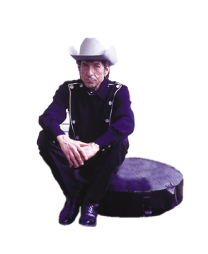A protean physical phenomenon and never less than a spectacular camera subject, Bob Dylan has met with uneven success in movies. Given his imagistic radiance and gifts of storytelling compression, he would seem the most naturally cinematic of artists. (Compare the dramatic punch of Dylan’s “Hurricane” to Denzel Washington’s.) And clearly he has some ambitions in this direction, participating, in various capacities, in at least nine films. Yet outside of the documentaries, onscreen Dylan is all odd angles.1
In scripted roles like those in Hearts of Fire2 (1990) and Masked and Anonymous3 (2003), he perversely offers himself as an object of contemplation only to play the Sphinx.4 He does nothing to ingratiate himself, yet you can’t stop looking at him: not since Buster Keaton have we been treated to so great a stone face. This powerful anticharisma becomes something of a running gag in Masked and Anonymous:5 his impassivity becomes a scrim onto which the other characters—and the audience—project their dreams and desires.
Dylan’s burden as a film performer is the baggage he brings to every appearance—coupled with his nonactor’s inability to transform that audience rapport into something other than “Dylan.” In Pat Garrett and Billy the Kid (1973), Sam Peckinpah’s laid-back, elegiac manhunt movie, the director finds a halfway successful measure for transposing the musician’s presence into a suitably mythic framework. Dylan provided the soundtrack6—painted in jingle-jangle John Wesley Harding colors—and also costars as Alias, a mysterious member of Billy’s gang who’s good with a knife. He looks great in granny glasses, and his singsong, anachronistic delivery wouldn’t be out of place on Deadwood. That, and it’s the only film in which Dylan lassos a turkey while on horseback.
Looking like a hippie rabbinical student, Dylan enters the party late in Martin Scorsese’s The Last Waltz (1978), putting in a generous, good-natured appearance. Fully alert to the other members of the frame, Dylan relaxes as part of an ensemble; watching him communicate a song transition with the Band is thrilling. The Last Waltz also features the best piece of comic timing in Dylan’s movie career: a shrug following the first verse of “Forever Young.”
Flip sides of the same cinéma vérité coin, D. A. Pennebaker’s Don’t Look Back (1967) and Eat the Document (1972) chronicle Dylan’s mid-’60s England tours. The first film is better known for Dylan’s withering sparring sessions with the press than for its superb acoustic performances, while Eat introduces us to the Electric Dylan of the Polka-Dot Shirt. The physical transformation is as dramatic as the...
You have reached your article limit
Sign up for a digital subscription and continue reading all new issues, plus our entire archives, for just $1.50/month.
Already a subscriber? Sign in





